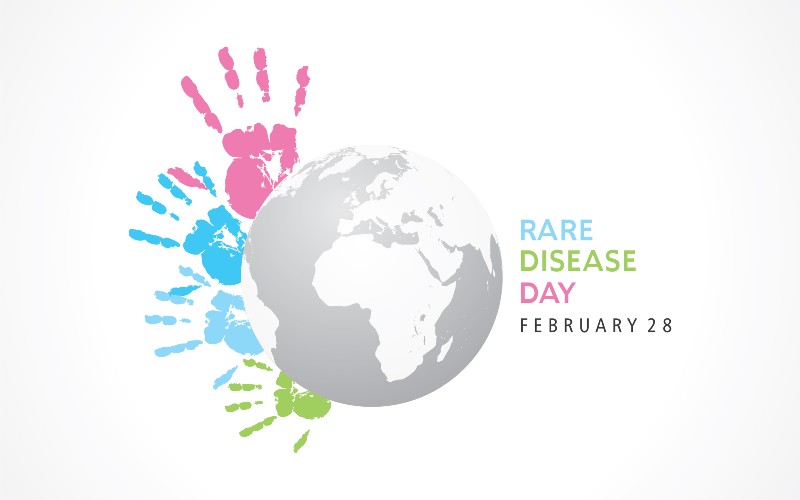
February marks Rare Disease Awareness Month culminating in Rare Disease Day on 28 February (or the 29th in a leap year) which is a globally recognised day to not only promote awareness of rare diseases but to celebrate the achievements of those who suffer from them.
Even as someone with a rare condition, I hadn’t actually heard of Rare Disease Day until recently which made me realise how important it is that we highlight the work that rarediseaseday.org do. They are working to find a balance between promoting social equality and equal opportunities for those suffering from rare conditions but also to appreciate those things that make us different and unique.
Life can sometimes be very daunting for those of us with medical conditions or disabilities and even more so if you throw a rare disease into the mix that probably no one has heard of! The worry that no one will understand what you’re going through or what your abilities are, whether that be underestimating or overestimating them, is for many a reason not to put yourself out there. One area in particular which can give rise to such anxieties is around employment.
Whilst many people will have general worries over things like fitting in and getting along with new colleagues, this can often go deeper for those with medical conditions as they might be questioning things like whether their manager will understand and support their needs or whether there are physical barriers, such as are there stairs or an accessible toilet, like I had to consider.
As for my personal experience, I have been very fortunate to find an employer who already had an accessible office so very little had to be adapted for me but more than that, I was even luckier to find an employer who was willing to look at adaptions that I perhaps didn’t fully need but would still make my working life easier. That meant the only thing I had to worry about was whether I could reach the kettle in our team kitchen and even that problem was quickly solved!
Unfortunately, I know not everyone is as fortunate as I have been but these concerns should not put someone off entering the workforce and certainly should not dissuade an employer from hiring someone with a disability or rare medical condition if they are the best candidate for the role. There are some services such as Access to Work which can offer grants, advice and practical support and the Health and Safety Executive has also issued guidance on the topic for both employers and employees. With that in mind, I wanted to highlight some steps which I’d recommend taking to promote a safe working environment.
Whilst all businesses and organisations should have a clear risk assessment to underpin their health and safety procedures, it is important that a specific risk assessment be carried out for any individual employee whose needs might differ from ‘the norm’. For myself, my risk assessment focussed on issues that might arise for a wheelchair user such as moving safely around the office space without obstacles and, before we went paperless, only using lower filing cabinets for my files to avoid me straining and stretching. However, someone working in a more manual field will have different considerations to take into account, for example, if working as a delivery driver there are weight limits to lifting which should apply to everyone but the driver in question may need a lighter maximum load to avoid a risk of injury.
Another very important consideration is to ensure there is a fire evacuation plan to accommodate the employee’s needs. Again, using myself as an example, our team is based on the third floor of our office and with no lift available during an alarm, I’d have been a sitting duck. However, a plan was quickly put into place to ensure my safe evacuation using an evac chair and that was hugely reassuring to know that I was covered in an emergency (touch wood it hasn’t happened yet!). Whilst the basics of my plan are probably quite common amongst those with reduced mobility, it wouldn’t necessarily help someone who was hard of hearing or had issues with their eyesight so they would need their own personal evacuation plan.
Such risk assessments do not necessarily need to be complex or cumbersome but they are so important, especially if the condition is rare as it might not be immediately apparent to an employer what the condition actually entails or what the employees’ needs are as a result. It would also be helpful to reconsider any risk assessments or fire evacuation plans if an employee even has a temporary change of circumstances, such as a pregnancy or an unexpected injury. For example, an office based employee returning to their desk job on crutches might think they are fine to return if they can use the lift but could struggle with the fire evacuation stairs in an emergency.
Lastly, it is really important that an employee is honest with their employer about their abilities. You might not wish to discuss your condition in any great medical detail but your employer needs to know enough to make sure they can keep you and your colleagues working around you as safe as possible. Those with medical conditions are not necessarily at any greater risk of a work related accident or injury providing these risk assessments, appropriate precautions and, if necessary, adaptions are put into place.
